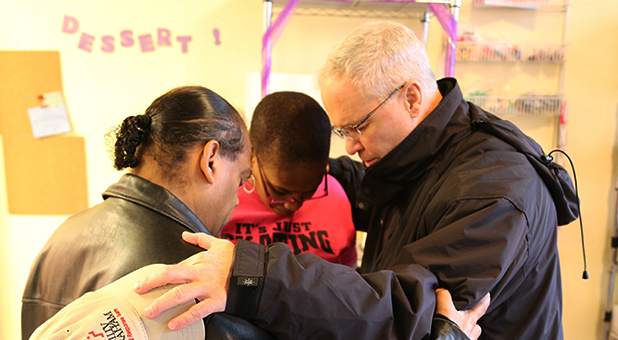Beyond the Burned-Down Buildings: ‘Looking for Healing’ in Ferguson
“This is different than a tornado or flood,” said Billy Graham Rapid Response Team chaplain Strib Boynton as he maneuvered his truck through the streets of Ferguson, Missouri. “This is changing the hearts of people, of a whole community.”
Memorials set up around Ferguson.
And it’s true. This response is unlike anything the crisis-trained chaplains from the Billy Graham Evangelistic Association have ever encountered in the decade-plus history of the ministry.
Whereas a natural disaster often leaves a wide swath of destruction but dissipates in a way that allows for healing and reconstruction, the unrest in Ferguson following the death of Michael Brown is a tragedy of distrust and anger—issues which cannot be solved simply by carrying out moldy carpet or patching a roof.
“They feel hopeless and they need to be reminded that all hope isn’t lost,” said Vivian Dudley, founder and evangelist for One Church Outreach Ministry, as she sat with chaplains just yards away from a dumpster bearing the spray-painted words “If we burn, you burn with us!”
“What the enemy meant to do was to box each of us in to feel like hope is lost. I think that right now the spiritual climate is they need a revival.”
But is it possible? Can peace and faith arise from the ashes of burned buildings and broken hearts? Can reconciliation—and even revival—be borne of the riots?
While hopelessness still weighs heavily on this town of 21,000, there are glimpses of redemption.
The Rapid Response Team’s Mobile Command Truck—parked on space provided by Bishop Giovanni Johnson of the Center for Hope and Peace—has become a meeting point for many. Throughout the day, a wide array of people—gang members, pastors, police officers, fire fighters, community leaders, family members of Michael Brown, and others—pass through to have a cup of coffee, perhaps get out of the rain, and share their stories with the chaplains.
Chaplains cry out to God with members of the Ferguson community.
“This has been an incredible experience for us in Ferguson,” said Jeff Naber, manager of chaplain development and ministry relations, who has been in the city for nearly a week. “We’ve had gang members the last two days—we’re talking about hardened street gangs—and they are curious. They came in, sat down, and prayed with us. They support us and have offered to take us into the community to minister.
“We’ve had people from the community who have been portrayed as being on opposite sides of this division, but who have cried together, embraced each other and prayed together. There is still a storm raging, but they’re looking for healing.”
One thing that many who have talked with the chaplains agree on is that if hope and reconciliation are to come to Ferguson, it needs to be spiritual healing.
Dudley, who has her own miraculous story of addiction and redemption on the streets of Ferguson and neighboring Jennings, said, “You see burned down buildings. I see buildings laying prostrate before the Lord. There’s a verse that says if they keep quiet, I’ll make the rocks cry out. I see the buildings saying, ‘Now behold the Lamb.’ Because of where I’ve been, I see so much hope.”
Similarly, Bishop Johnson, who is in the process of renovating a former steak house into a gathering place for young people to learn and develop job skills, said, “God has to intervene. God has to intervene, and it could start here.”
“We’ve heard from several pastors, and they view this as raw spiritual warfare. That’s what it is, and it’s very obvious,” said Naber. “But with that said, the potential for revival here is extreme.”
You can read the original article at billygraham.org.














































